Displaying items by tag: Peter Malone's Movie Reviews
After Blue/ Paradis Sale
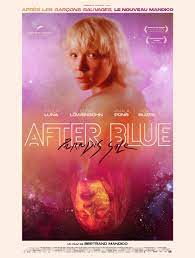
AFTER BLUE/PARADIS SALE (DIRTY PARADISE)
France, 2021, 129 minutes, Colour.
Elina Lowensohn, Paula-Luna Breitenfelder, Vimala Pons, Agata Buzek.
Directed by Bertrand Mandico.
A bizarre experience! An arthouse experience which will not attract the average audience.
After Blue is the name of a planet. The subtitle the film states that it is a Dirty Planet. Earth has failed, is rotten, men dying out, the women escaping to this faraway planet for a new existence. Explanations are given of how the women can be inseminated to continue the line. In terms of relationships and sexual experience, the film has many lesbian moments.
The most striking thing about the film, apart from the bizarre plot, is the impact of the sets and decor, a range of locations for the dirty planet, deserts, the sea, mountains, narrow passes, dark caverns… And all filmed with a different kind of colour palette from most films.
As regards the plot, as it progresses, many will start to think of American Westerns, journeys and quests, the role of the gunfighters, the bounty hunters in pursuit of criminals.
And that is the case here. The film introduces us to a teenager, a loner, Roxy, who is ignored by three teenagers, mocking her. She discovers a buried body, a woman, hairy arm, emaciated, and digs her out of the soil. This is a Polish refugee to After Blue, with her Polish name abbreviated (with a nod to the singer) Kate Bush. She offers Roxy three wishes, the first to destroy her friends who immediately suffer and die – later to appear in the quest, following and tormenting Roxy.
Roxy is blamed for what has happened, and her mother, Zora, the community’s hairdresser, having to take the blame, losing all her custom. The main part of the film is the commissioning of Roxy and Zora to go out in pursuit of Kate Bush and bring her back to justice.
There are many eerie episodes on the way, contact with strange locals, an attractive but sinister companion on the way, Sternberg, attracted to Roxy, protecting, causing difficulties…
And, finally, there is the confrontation between the travellers and Kate Bush herself, trying to be persuasive, justifying herself, but the two women with their guns, Gucci guns, building up to a dramatic climax.
A specialist cinematic experience.
Simulant
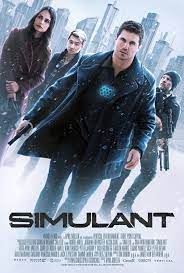
SIMULANT
US, 2023, 95 minutes, Colour.
Robbie Amell, Jordana Brewster, Simu Liu, Sam Worthington, Alicia Sanz.
Directed by April Mullen.
Stimulants is in the tradition of films with the pursuit of robots in control, Blade Runner being the archetypal film. It is suggested that this story is a variation on the writings of Isaac Asimov.
This is a Canadian production, an interesting cast including Australian Sam Worthington, set in the near future, the vistas of a vast industrial plant as well as of a thriving city.
The film begins with two stories, the marriage of Evan and Faye, his nightmares, a crash, some alienation between the couple, the wife finally revealing that after the accident he became a simulant. Faye cannot relate well with him and urges him to some treatment, a connection with a hacker, Casey.
The other story is that of Kessler, Sam Worthington, officially pursuing simulants, an opening sequence in pursuing a simulant called Esme who is then taken to the laboratories for research and reconstruction.
There are further emotional complications as Evan discovers more of the truth about himself, the Evan inside him but also the simulant and his affinity with the other AI creatures, working with Casey, confronting Kessler, killing Faye, and a sign of the uprising of AI against the humans.
- The near future? Artificial intelligence? Robotics? Simulants?
- Canadian production, the settings, the overview of the industrial plants, interiors, modern, laboratories, apartments, swimming pool? The musical score?
- Two stories in one, Evan and Faye, Kessler and his pursuits? Combining them? Through Casey?
- Tradition of science-fiction and simulants, Asimov stories, Blade Runner…?
- Evan and Faye, the marriage, life together, his waking from nightmares, the crash? Puzzling about himself? Faye’s treatment of him? Sense of alienation, the question about the accident, the consequences, the revelation that he was a simulant? The consequences, his relationship, Faye not feeling that he was the same person, the revelation, taking him to Casey? The elimination of memories? The effect on Evan, with Casey, learning the truth, becoming embittered, the escape with Casey, the confrontations, his killing Faye?
- Faye, the marriage, the crash, her husband coming a simulant, not being able to relate to him, yet the care and concern, the sexual encounter, her swimming, sending him away, his return and her death?
- Kessler, hunting the simulants, the pursuit of Esme, his powers, the control, capturing her, the laboratory, reworking her, her link with Casey, Kessler and the doctor leaving, Esme ringing, Casey and his escape? Kessler in pursuit? The fight, the shootout?
- The attitude of the humans, making the simulants, the auction sequence, the robots serving in the house?
- Casey, hacker, changing people, with Kessler in the apartment, with Evan, with his double? The escape?
- The change in society, the uprising of AI, the revolution?
Endangered Generation?, The
THE ENDANGERED GENERATION?
Australia, 2022, 85 minutes, Colour.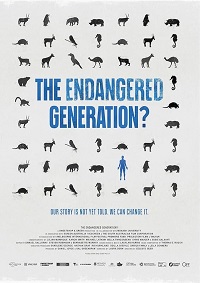
Narrated by Laura Dern.
Directed by Celeste Geer.
The Endangered Generation?
Official Summary: Combining modern science with ancient First Nations knowledge, The Endangered Generation? seeks new ways of thinking about the many crises facing our planet. Our world is at a crossroads of myriad crises, but all too often the solutions to the problems we face - especially vis-a-vis climate change - are put in the "too hard" basket. But, as director Celeste Geer discovers, it doesn't have to be this way. Following Then the Wind Changed, her Walkley Award-winning film about rebuilding after the 2009 Black Saturday bushfires, she seeks answers to the question of why, after decades of warnings, we continue to shirk the necessary measures that will prevent all-out climate catastrophe. The Endangered Generation? aims to remove roadblocks to change by presenting new and hopeful angles on the tasks required. In the lead-up to COP26, Geer met with scientists, First Nations leaders and communities from around the globe who, through their research and experiences, are showing how collaboration, imagination and creativity - in particular, Indigenous knowledge systems - will likely be the most effective tools for surviving the world we now find ourselves in. A moving, and at times surprisingly joyous, exploration of who we are and how we relate to the environment, the film reveals not just a potential salvation for humanity but a salve for the anxieties and uncertainties of modern life.
This is an Australian production, with backing from Monash University and other institutions. Some sequences were filmed in Australia, with acknowledgement of First Nations and their traditions, and speakers. The film opens in Panama, an emphasis given to that country, its status as carbon-free, focus on its First Nations people, their aspirations, the talent in weaving – and the presentation by the delegate to COP 26, Glasgow, 2021, making a strong impression, as well is the presentation of the weeping.
Filming was also done in Indonesia as well is in Antarctica.
This is one of many documentaries with a sense of urgency for tackling global climate issues. However, while a lot of the material continues to be urgent, the ending is somewhat dated with its taking place at COP 26 in Glasgow, with Boris Johnson, soon losing his prime ministership, as host.
The advantage of this kind of documentary is that it can be available to a wide audience, streaming, television, and available for groups discussing issues as well as providing background and information.
While it has a cumulative effect, it may well be more effective if shown in sections with discussion afterwards, some of the key speakers who communicate with strength and conviction, and some of the beauty of visuals as well as tragic changes around the world.
One of the difficulties is that it raises the question of whether films like this are preaching to the converted and whether they have opportunity for reaching a wider audience. One hopes so.
Spider's Web, The/ 1960
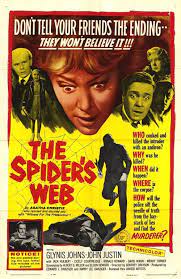
THE SPIDER'S WEB
UK, 1960, 89 minutes, Colour.
Glynis Johns, John Justin, Jack Hulbert, Cicely Courtneidge, Ronald Howard, David Nixon, Wendy Turner, Basil Dignam, Ferdy Mayne, Peter Butterworth, Anton Rodgers.
Directed by Godfrey Grayson.
Based on a play by Agatha Christie. However, it is very slight, even lighthearted in comparison with The Mousetrap and, especially, Witness for the Prosecution.
The action all takes place in a mansion, over a couple of hours. The running time is brief – the remake in 1982 with Penelope Keith is 15 minutes longer.
The first 20 minutes or so establish the characters, especially Glynis Johns as the new wife of diplomat, John Justin, prone to speculating and imagination, influencing her stepdaughter in the same vein. There are mysterious servants. And there is a mysterious gardener, Mrs Peake, played by Cicely Courtney. The mansion was previously owned by an antiques dealer – and there is a secret object which the murder is after.
The action develops when a sinister visitor arrives, who has married John Justin’s ex-wife. He claims to come to get the daughter back. However, he returns, searches a mysterious desk, and is found murdered. While the stepdaughter has played with some voodoo dolls and is upset that she killed the visitor, her stepmother decides to take the blame, calls back her friends who are at the club to help her move the body.
Many will remember The Trouble with Harry or Weekend at Bernie’s and disappearing corpses. Fortunately, this old mansion has secret doors and a secret hiding place!
While there is the question of who done it, there is the big question of where to hide the body. Peter Butterworth, in unusual casting, is the police inspector. The friends of the family include a neighbour, a magistrate, a former member of the Secret Service.
The whole thing seems rather dated, 1960s style, rather stage bound, and a somewhat flighty performance, which many have found charming, from Glynis Johns.
Ronald Howard (son of celebrated actor Leslie Howard) with his glasses and build seems to be anticipating Colin Firth!
And, there is the satisfaction of finding out, eventually, whodunnit.
Never Look Back
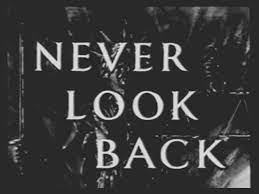
NEVER LOOK BACK
UK, 1952, 73 minutes, Black-and-white.
Rosamund John, Hugh Sinclair, Guy Middleton, Henry Edwards, Terrence Longden, Brenda de Banzie.
Directed by Francis Searle.
A brief second feature from 1952, a curio item for those interested in the British film industry in the late 1940s, early 1950s. And it has a cast of British character actors, including an early appearance by Brenda tde Banzie and an uncredited appearance by Harry H.Corbett as the guard in the prison.
This is a film about lawyers and crime, raising ethical issues, about a defence lawyer having personal issues with the man she is defending.
Rosamund John plays a lawyer who has become a KC, celebrates with another lawyer who is in love with her, Hugh Sinclair. However, she is committed to her career. She is sent congratulatory flowers and remembers a man she had fallen in love with in Italy years earlier. He then arrives, evokes memories of the past, says he has fallen on hard times and she offers him the couch for the night, knowing that it might risk her reputation.
The visitor has mentioned his girlfriend and, the next morning, she is found dead. He is arrested. The lawyer decides to defend him against the advice of her partner and his father. And the circumstances mean that her friend lawyer is to be the prosecutor.
Much of the second part of the film is in the court, the interrogation of witnesses, the defendant clearly moving towards a guilty verdict, especially when a woman of dubious reputation, played by Brenda de Banzie, testifies that she saw the defendant at the time of the death, his lawyer interrogating the witnesses to try to find extenuating circumstances. When it seems that he will be guilty, the defendant causes a tantrum in the courtroom, appealing to the lawyer to defend him. She resigns, later going to the witness box and admitting the truth.
Found not guilty, there is confrontation between the defendant and the prosecutor, and the clear indications that the murderer had set up the situation, to have an alibi when he went out to kill his girlfriend.
The moral issues and legal issues are set out clearly – but, with a rather sudden happy ending.
Case Against Mrs Ames
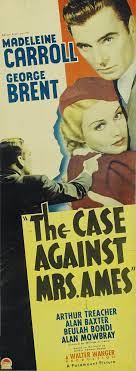
THE CASE AGAINST MRS AMES
US, 1936, 85 minutes, Black-and-white.
Madeleine Carroll, George Brent, Arthur Treacher, Alan Baxter, Beulah Bondi, Alan Mowbray, Brenda Fowler, Esther Dale, Edward Brophy, Scotty Beckett.
Directed by William A.Seiter.
British Madeleine Carroll was one of the highest-paid actresses in the mid 1930s. She had appeared in Hitchcock’s The 39 Steps as well as films in the UK. She also went to Hollywood. This film came immediately after The 39 Steps.
This is a court case, crime thriller set in the wealthy families of San Francisco. Mrs Ames has been charged with the murder of her husband, the verdict in the case seeming to go against her. The prosecutor has withdrawn and a brash substitute steps in, played by George Brent. He is outspoken and mocking but allows Hope Ames to speak to the jury. She does so movingly, is acquitted, the prosecutor making a show of protest and finishing up in jail with a large fine.
Hope Ames finds herself in a difficult position, her mother-in-law, a severe Beulah Bondi, turning her little son, Scotty Beckett, against her. On the grandmother demands adoption rights.
The development of the film is Hope Ames paying the fine, employing the prosecutor to investigate the murder even though he still is convinced she is guilty. Even her own defence counsel, played by Alan Mowbray, tells her that he believes she is guilty.
Arthur Treacher does and enjoyably familiar turn as the very British Butler.
The investigation leads in many directions, ultimately showing the bad reputation of the murdered husband, the links with the investigating lawyer, more court scenes, test me the full boy against his mother, some club hostesses giving testimony against the murdered man, the outrage from his mother.
Along with the serious drama there are many comedy sequences, especially featuring Edward Brophy as a photographer, always trying to get the right photo, his journalist sidekick, who she is always get stuck on the chewing gum spat out by the photographer! There is a raid by the prosecutor on the office of the defending counsel and an expose – and happy ending.
An example of easy popular entertainment from Paramount in the 1930s.
Poesias para Gael
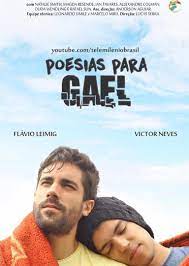
POESIAS PARA GAEL
Brazil, 2017, 106 minutes, Colour.
Flavio Leimig, Victor Neves, Natalie Smith.
Directed by Victor Neves.
This film was written and directed by Viktor Never who plays the central role of the title, Gael.
This is a film principally for a gay male audience. And, it combines various gay themes, dramatised very emotionally. In fact, this is a very emotional film, could even be called sentimental at times, not a film for audiences who want or moral a more rational style of filmmaking and theme exploration.
At the centre are three friends from school days. Eline, Natalie Smith, has had a crush on Gabriel but has been ignored by him. Angry, she asks the other friend, Hugo, to find out whether Gail is gay. More emotional complications, especially the relationship between Hugo and Aileen, her resentments, mixing with other men, her becoming pregnant.
In the meantime, Hugo discovers his feelings for Gail. Which means that the first part of the film highlights self-discovery, love and affection, sexual attraction, a crisis with the pregnant and lean, Gael and a possible illness, the initial wariness of Gail’s mother.
The bonding between the two men is very strong. However, Hugo has to go to visit his family in another city, is approached by a manipulative former girlfriend who sends compromising photos and answers the phone to go. Hugo has to make every effort to reconnect with KL who is consoled by his mother and a visit from an aggressively sexual cousin.
The next stage of the film is reconciliation, using the title of the film, Gael having been a published poet, but Hugo writing columns for reconciliation. The next’s marriage, the preparations, the enthusiasm of the mother-in-law, the hesitation of Hugo’s mother, Aileen and the reconciliation and her contribution to the wedding ceremony. Same-sex marriage was made illegal in Brazil in 2013.
There is the pathos in the comedy of the wedding, the woman in charge being alcoholic and causing a fuss, embarrassing to her young son.
The next step in the drama is adoption by gay parents, the two men wanting to adopt the abandoned boy and his being willing. There is prejudice against the two men, but the boy escaping from foster parents and their becoming his guardian. There is also the emotion of their moving out from Gail’s mother’s house – not far away. But, happy ending.
As a postscript, the director and cast together for a short subsequent film about the two men going on holiday leaving the boy to the care of Gail’s mother.
A film definitely for its target audience.
Calling Paul Temple
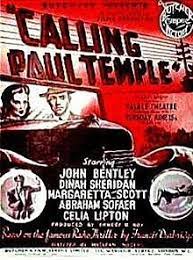
CALLING PAUL TEMPLE
UK, 1948, 92 minutes, Black-and-white.
John Bentley, Dinah Sheridan, Margaretta Scott, Abraham Sofaer, Celia Lipton, Jack Raine.
Directed by Maclean Rogers.
This is the first two films focusing on writer and detective, Paul Temple, played by John Bentley with Dinah Sheridan as his wife. The second film, 1950, was Paul Temple Triumphs.
The significant contributor to this film is the writer, Frances Durbridge, popular with his many novels, the Paul Temple series going to radio for over 30 years, later at 24 part television series with Francis Matthews as Paul Temple. John Bentley himself featured in quite a number of small-budget British supporting features in the 1950s but was very successful in the television series, 255 episodes, Crossroads, from the mid-60s to the mid-70s.
The film opens on the train, a mysterious death, a signature on the blind, REX. It appears that this is one of a series of murders, investigated by various police, and interest from Scotland Yard, calling in the the assistance of Paul temple with his writing and detective skills. And, in this story, strongly assisted by his wife in all investigations.
Surprisingly, the next sequences in a nightclub, many affluent guests, a spacious singing and dancing area, and a performance, attractively provocative, by Celia Lipton. And, then more surprisingly, another song. However, we have seen in her dressing room she has written a note for the police to give them information about the murders. During a performance, she collapses and dies.
As expected, there is quite a range of suspects, a particular focus on a dpctpr, played by Abraham Sofaer, three of his patients have been killed. Then there is a strong, sometimes mysterious presence of his assistant, played by Margaretta Scott.
For audiences who enjoy this kind of small-budget, supporting feature film, the type of story so popular in television series to come, there are plenty of suspects, moments of danger, twists, even including the Dr hypnotising his assistant and forbidding her to give information.
And, as a bonus, there are many sequences actually filmed in Canterbury, in the streets, hotels, cafes, Cathedral, ruins of friary’s…
There is a twist in the solution, the common denominator being Egypt’s prior to World War II. However, there is something of an anti-climax because audiences enjoy the unmasking of a significant murderer race here he is not such an interesting and dramatic character!
Dea di Fortuna/ Goddess of Fortune
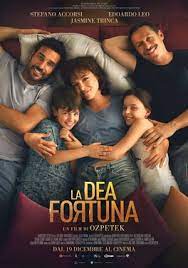
GODDESS OF FORTUNE/ DEA DI FORTUNA
Italy, 2019, 119 minutes, Colour.
Stefano Accorsi, Eduardo Leo, Jasmine Trinca, Sara Ciocca, Eduardo Brandi, Barbara Alberti, Dora Romano.
Directed by Ferzan Ozpetek.
Ferzan Ozpetek, originally from Turkey, living in Italy, has been making striking human drama since the end of the 1990s. Here he is with his themes, 20 years later.
Ozpetek is a gay man, a gay director, sexual orientation being significant in most of his films. Here is a variation, and established relationship, over many years, over many years, ups and downs, ambitions frustrated, infidelities. The couple is played by veteran actors, Stefano Accorsi and Eduardo Leo.
The title is taken from a statue of the goddess of Fortune in a monument in the town of Palestrina where the woman at the centre of the film works and which has an influence on her children.
At the core of the film is the relationship, from the past, with a woman who has rebelled against her harshly strict mother, left home, has entered into relationships, has a daughter, forward and outspoken, and the younger son, rather more prim, father uncertain. She is played by veteran actress, Jasmine Trinka.
On the one hand, the issue is of the woman and her being ill, diagnosis and prognosis, hospitalisation. On the other hand, there is the issue of who will care for her children while she is in hospital, her wanting to entrust them to the men. This raises the issue of gay couple, parenting, responsibilities, capacities, society’s attitudes. However, they are surrounded by an eccentric group of friends who are very supportive.
With the serious illness, a decision is made that the children should go back to stay with her grandmother, the men travelling to take her, encountering the harshness of the old woman, but also meeting her companion/servant. They leave the children.
The story becomes more serious when the woman dies, the men coming for the funeral, discovering that the old woman is treating her granddaughter as harshly as she did her daughter, a dilemma for them because they are in personal conflict, the discovery of an affair, one of the men frustrated in his ambitions in academia, forced to do translations, the other a labourer, discovering that his partner had been cheating and wanting to leave.
The drama comes to a head, the men fortunately being helped by the sympathetic companion, taking the children – and facing the prospect of a middle-aged gay couple taking on the role of parenting.
- Family drama, mother and children, gay couple and fathering?
- The settings, the Italian city, homes, building worksites, the streets, markets, hospitals, the boat journey, the country mansion and interiors? The musical score?
- The opening, the atmosphere, the party, straight, gay, transgender? Setting the tone?
- The story of Arturo and Alessandro, their age, 15 years together, memories of their first meeting, friendship with Anna Maria, homosexuality, partners, settling, home and companionship? Arturo and his story, his later recounting what he gave up, University professorship, his writing, work on translations, keeping house? The contrast with Alessandro, the plumber, practical, out on the job? The ordinariness of the relationship, the loss of passion, the revelation Arturo and his affair with the artist, his physical collapse, calling Alessandro, the truth, taking him home, a two row and his plan to leave?
- Into this setting, Anna Maria, the story of her past, her harsh mother, escaping, men and partners, her two children, her health, coming to her friends for help, in hospital, the doctors, tests, the brain, the need for surgery? The visits of the two men to the hospital?
- The children, entrusted to the two men, their range of friends, characters, the couple, the old lady…? And trusting the children to their care for an hour? Alessandro taking the boy to the house for the plumbing job, saying that he was apprentice? Martina, interactions between the two, friends, fights, Alessandro and his formal manner, polite, Martina more forthright? With the men, the meals, telling stories, sleeping arrangements? The men responding to the demands of care? The children and their concern about their mother?
- The background of the difficulties, the two men and their clashes, fighting, arguments? Future arrangements? Alessandro and his disappointment about the affair?
- Anna Maria, writing the document about the men to look after the children? Her leaving hospital, dressing up, urging them to take the children to her mother?
- The voyage, the mother, wealthy, harsh, taking the children, her reliance on Leah?
- Anna Maria, her death, the grief, the voyage back to the country mansion, the grandmother and her looking after the children, her reaction to the men, harsh denunciations of them, condemnation of her daughter? To keep the children, demanding that the men leave?
- The importance of Leah, her devotion to the grandmother, the years? Yet the criticism? Helping the men, getting the children to escape, going back to Rome?
- The effect on the men, the death of Anna Maria, the memories, possibilities for forgiveness, love continuing, the bonding, and the children keeping them together?
Nuovo Olimpo
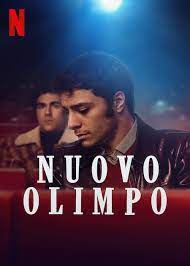
NUOVO OLIMPO
Italy, 2023, 113 minutes, Colour.
Damiano Gavino, Andrea de Luigi, Alvise Rego, Luisa Ranieri, Greta Scarano.
Directed by Ferzan Ozpetek.
Ferzan Ozpetek came from Turkey to Italy in the 1990s and settled there, becoming a writer and director, many serious dramas for more than a quarter of a century.
The director is a gay man and homosexual relationships are central to most of his dramas. In 2019, he probed the issue of same-sexual relationships in the context of parenting.
In this film, the development of the relationship is somewhat in reverse, a young man involved in the film industry encountering a student doctor, the beginnings of an intense relationship, and then circumstances changing, a lost relationship. And the director uses the passing of time for the drama,
Time, space and distance.
The film opens in 1978 in Rome, a scene of filming near the Forum, the encounter between the two men, the context of political terror at the period, riots, stances, arrests. The film then moves forward 10 years to 1988, by this time the young man a middle-aged successful film director and the other man a successful doctor, ophthalmologist. And then the film moves to the early 1990s, focusing on the time of the death of Federico Fellini and its effect on Italian filmmakers – and the filmmaker momentarily seeing the doctor through the windows of a train.
And then the film moves to 2015. The director has had a very successful career, admired by the media and critics, an openly gay film director. The doctor has been married for many years, has a social life, a successful career in eye surgery.
Now comes the contrivance to bring the two men together again, an eye accident for the director at the studio, the surgeon operating on him. The director being bandaged, but detecting the voice. Complications at home, and a final meeting, an acknowledgement of what has happened over the decades, and, over the final credits, a reminiscence and wistfulness of what might have been.
The opening part of the film is quite explicit in its presentation of nudity and the sexual relationship, later the film reflecting on this kind of openness.
And the title? In 1978 it is a cinema which specialises in Italian classics, changing program every day, but also its corridors and toilets being used as a gay pickup centre. At the cashier’s desk is a significant character, Titti, who befriends both men and is later significant in the development of the plot. By 1988, it has become a sex cinema. So, the cinema comes symbolic of the men, for the men, issues of relationships and sexuality.
- The career of the director, Turkish-Italian, his perspectives on Italian life? Relational issues, and the sexual relationships?
- The title, the classic cinema, screening classics daily, and the audience, rendezvous for gay cruising, the regular men, the customers, the toilets? Titti the cashier? The usher? 1978? 1988 and the tradition to its being a sex cinema? The place for the meeting between Enea and Pietro? Memories?
- The audience for the film, the gay audience, identifying with the characters, their experiences, the relationship? The explicit nudity and sexual encounters? These sequences for the ordinary audience? Significant for the development of the narrative, characters and relationships?
- The character of Enea, the opening, the scene at the Forum, the woman shooting, the scene from the film, the crowd watching, Pietro watching, and his job, the gaze between the two men?
- Enea, his age, student of cinema, working on sets, his relationship with Alice, sexual, friendship? His orientation, attending the cinema, watching the film’s and studying them, yet knowing the cruising men, antagonism with the usher, friendship with Titti? The encounter with Pietro, the toilet, his refusal, the next day, the encounter, going to the grandmother’s house, tentative, impassioned, the dance sequence, the aftermath? The effect on each of them?
- Pietro, age, student, medicine, visiting his mother, the surgery? Gay orientation, going to the cinema, seeing Enea, the initial reluctance, the meeting, the encounter and the aftermath? The visits to the cinema?
- The political background of 1978, antifascist demonstrations, the character of Molotov and his making the bombs, his friend and the protests, Alice and the protests, urging Enea, his declining? The meetings with Pietro, the films, the meals, the plan for Pietro to visit his mother, their meeting up for the meal, the protests, the police pursuing them, into the cinema, Enea’s escape, Pietro, the police pursuit, run over by the car, his broken arm?
- The broken contact, 10 years passing? Enea, his career, successful director, his film topics, the media, friendships, his world? Pietro, doctor, ophthalmologist, Giulia, the marriage, his relationship with her?
- 1993, the death of Fellini, Enea and his upset, in the train, looking across, seeing Pietro with his wife, the train drawing away? Enea and his being celebrated? The party, the relationship with Alice, Antonio, imposing presence, making the cake, the two seemingly different, the kiss, the relationship, the long relationship?
- Enea at the supermarket, the encounter with Titti, reminiscing about the past, her ambitions, dressing like the singer, Mina, her apartment, the letter from Pietro, the conversations, finding the letter, Enea ringing but the phone number not valid, the fact that Pietro had returned to the cinema, reached out? And the sad effect for Titti as Enea other left?
- 2015, so many years passing, Enea and his 14th film and the celebration? At the studio, the setup, the accident, the glass in his eye? The hospital?
- Pietro, the relationship with Julia, the many years, their social life, tensions, his career? The scene with the two couples watching the same film with Anna Magnani, memories of the past, the conversations?
- Pietro, going out, going to the press conference, Enea a celebrity, praising Antonio, the public response?
- Enea going to hospital, Pietro being asked to do the surgery, his hesitation, performing it, Enea and his eyes covered, recognising Pietro’s voice? The aftermath?
- The phone call, Enea wanting Pietro to visit him, Giulia speaking on the phone, inviting him to the meal, the others not coming, his arrival, the two men looking at each other? Giulia, her comment, that Pietro had never looked at her like that, they are urging him to follow?
- Pietro, willingly going, finding Enea, together, so m yearanys passing, Enea going home, urging Pietro to go home?
- And the finale with the credits, tracking back to the restaurant, the meals of the past, what might have been?